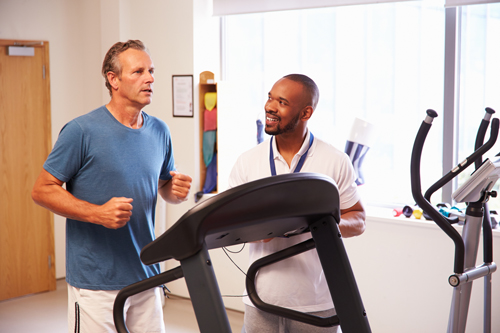
Say you have experienced intermittent pain in your legs after walking or climbing stairs, but you brush it off as an unfortunate side effect of aging. Maybe you have noticed that the hair on your lower leg is growing more slowly or that the skin looks paler on your leg than on the rest of your body, but again, you assume it is just a random occurrence. These symptoms, however, are actually signs of peripheral artery disease, or PAD.
PAD is quite common in older individuals—especially those with high blood pressure or cholesterol, diabetes or who smoke. The condition occurs when a build-up of plaque (called atherosclerosis) causes the arteries in the legs or pelvis to narrow, reducing the blood flow to the extremities.
Luckily, PAD is easily diagnosed with simple tests and can usually be treated with lifestyle changes and exercise. Cessation of smoking and eating more healthfully can counteract the effects of PAD. In addition, we can design and implement an exercise regimen using interval training to treat PAD. Exercise also
- assists in weight loss efforts
- helps maintain circulation
- lowers blood pressure
- increases HDL (“good”) cholesterol
- lowers blood glucose (sugar) in persons with diabetes
- improves the overall condition of the heart and blood vessels
Ironically, to provoke healthy changes in the arteries, you will need to work the muscles that cause the pain in your legs (known as “claudication pain”) to a point of discomfort. We can ensure that you are feeling “good” pain, rather than pain that may be a danger sign. Because people experiencing PAD are often at higher risk for stroke and heart attack, it is important that you see your physician before starting an exercise program to be sure that you can safely participate.
The take-away message is that you should never ignore the strange pain in your legs that comes and goes. PAD is treatable, and it is always better to be safe than sorry when it comes to artery-related issues. Contact us so we can get you started on an exercise program to treat PAD.
















